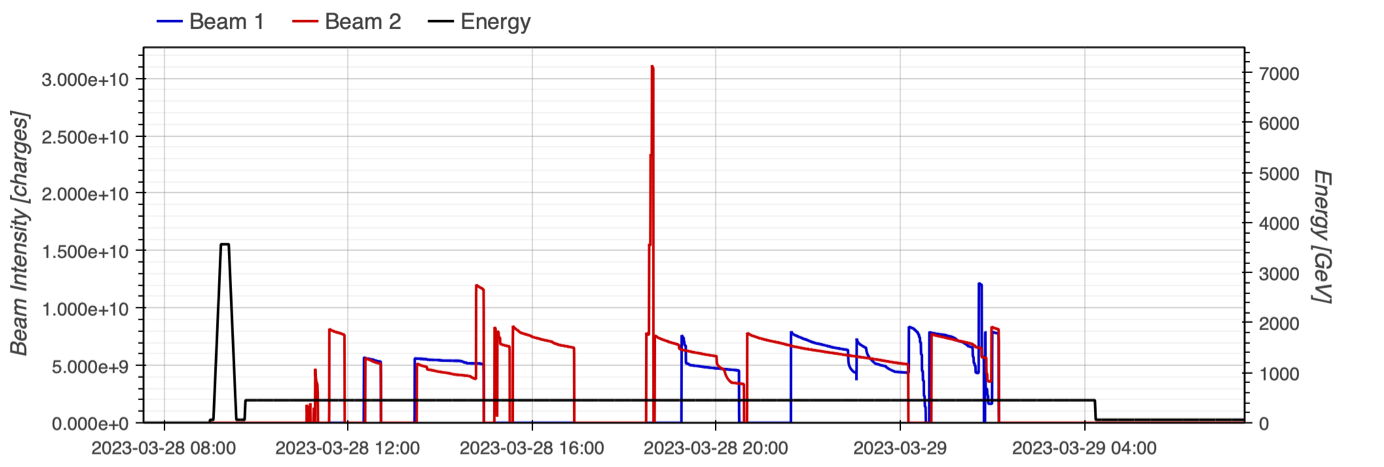On Wednesday 22 March, the LHC machine, the injection beam lines and all the experiments were closed for the cold check-out of the LHC, an important phase in the commissioning that follows the hardware tests and is a prerequisite for injecting beam into the machine. During this phase, all safety and interlock systems are activated and tested, and the machine is cycled as if there were beam in the machine to make sure that everything works correctly and on time.
On Monday 27 March, the date scheduled for first beam in the LHC, the machine would have been ready to receive the first beams, were it not for a single crystal collimator, which broke during the final phase of the hardware tests. A programme of work to resolve the issue started on Wednesday 22 March: the device was removed and a replacement vacuum chamber was put in place, followed by a vacuum pump down and a bake-out. The crystal collimator, which is only required for runs with Pb ions, will be repaired, tested, and reinstalled during the next technical stop, which is scheduled to start on 19 June.
With this work completed, the machine was ready for beam injection on Tuesday 28 March, only one day behind schedule. The first injections started after the 9 a.m. briefing. Beam 2 (counterclockwise) was circulating by 11 a.m., and beam 1 (clockwise) followed one hour later. The team in the CCC made the beams circulate in steps, stopping each beam at each experiment using collimators that were closed completely for that purpose. The secondary particle showers from these collimators, called splashes, are used by the collaborations to make first beam tests with their detectors.
Once the beams were circulating in the machine, thorough checks were made and the many machine parameters started to be adjusted, a process that is still ongoing. A detailed and regularly updated commissioning programme is now being worked through. Shifts are allocated to specific activities, such as setting up the optics and adjusting the collimators, and experts join the operations team in the CCC for this purpose. This programme was regularly adjusted as the beam commissioning progressed faster than expected.
However, this fast and smooth progress was abruptly brought to a stop by a power outage at LHC point 4 just before midnight on Saturday 1 April. Sectors 3-4 and 4-5, including the RF cavities located at point 4, warmed up, losing their superconducting abilities. Due to the power outage, the helium pressure in the cavities rose and the safety release valves came into play, relieving the overpressure in the cavities. Unfortunately, two rupture discs, which are additional safety components, opened. They were promptly replaced the same night, as soon as the power was restored. The following morning, the cavities were refilled with liquid helium and the cooldown started. In parallel, sectors 3-4 and 4-5 were also recovering so that, by Tuesday afternoon, the beam commissioning could resume.
The detailed commissioning plan has been adapted as a result of these events and, provided that the remaining commissioning continues to progress smoothly, the time lost will be absorbed and should not delay the start of physics. The next major milestone will be reached when collisions are made at the injection energy, which should still be possible before the Easter weekend. Over that weekend, the operations team will continue to prepare the machine for collisions at high energy, which are scheduled to take place during the first weeks after Easter. Once these collisions have been achieved, the LHC will enter a period of beam commissioning interleaved with a ramp-up of intensity with initial data taking for physics. During this period, the number of bunches in the LHC will be gradually increased and, in parallel, the experiments will start taking physics data. The final commissioning steps will be completed during the remaining shifts, ready for the real data-taking season to start in mid-May.

